Applied Physics is the Mother of Invention
Alumni Spotlight: David R. Fischell
by Diane L. Tessaglia-Hymes
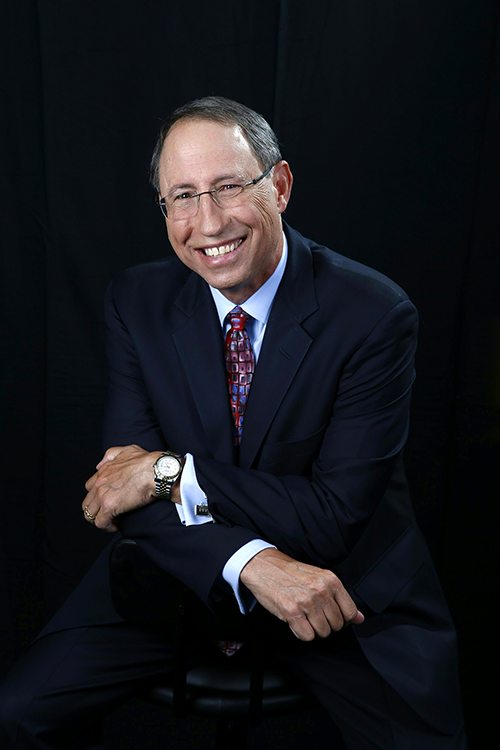
“I am an inventor and an engineer at heart.”
This self-assessment by David R. Fischell, (AEP B.S.’75, M.S. ’78 and Ph.D. ’80) barely hints at the extensive scope of his work, and the impact and wide-ranging benefits his inventions have provided to millions of people worldwide. A serial entrepreneur, Fischell has started 14 medical technology startups where he served 25 years as CEO with 15 of his medical products receiving FDA approvals, and led a 1986 Bell Labs Intrapreneurship Venture creating the forerunner to Go To Meeting and Zoom. He also holds 198 U.S. patents as of late 2023 and was instrumental in supporting the creation of the Department of Biomedical Engineering at Cornell, now the Meinig School of Biomedical Engineering (BME).
“I get bored, so I need to have projects that keep me engaged in creating new technologies, especially when they involve learning,” he said.
Recounting his path from student in applied and engineering physics to a career as an inventor, serial entrepreneur, and founder of BME, Fischell explained, “The best training in the world for engineers is to get a Ph.D. in experimental physics because you need to really understand the problem and the math and physics behind whatever you're working on; you have to design, build, and conduct an experiment; you then must collect and analyze the data, and create computer models; and finally, you have to write up your results and present and defend them. And if that doesn't train the world's best engineers, I don't know what does.”
“An applied physicist is basically the combination of a chemical engineer, electrical engineer, mechanical engineer, materials scientist, and a computer scientist. You've got to be able to work in any of those fields. And, you have to learn how to be able to understand the basic principles, and then build on those to figure out what's next. As an applied physicist, I have not been limited to mechanical or electrical technologies, but I have invented and designed tools for the medical field: catheters and stents, algorithms and devices for detecting and treating epilepsy and warning patients of impending heart attacks, and devices for infusing liquids into the body or into the space outside of an artery. And in all cases it's the same thing: you've got to be able to understand the problem, understand the technology and then figure out based on whatever innovative knowledge you have—or the knowledge of others— how to take it from where it is to bring it out as a product.”
Impact in the field of medicine
One of Fischell’s most important and successful inventions so far has been the technology and design of what became the world’s first drug-eluting stent for Johnson and Johnson (Figure 1). Based on the existing Palmaz-Schatz stent, which was strong and held arteries open, Fischell, his father Robert Fischell, Sc.D. and his brother Tim Fischell, (B.S. Arts ’78, Weill Cornell M.D. ’81) invented the way to make that strong, stiff stent also flexible—which was necessary for placing it in coronary arteries and maneuvering around arterial bends—and filed a patent in 1994 through their company, IsoStent, Inc., a company that developed radioisotope stent products and stent-delivery systems.

“We were first to the patent office,” Fischell explained. “It was the technology that Johnson & Johnson wanted, but their own internal engineers had not been able to design stents that were both strong and flexible. So, they bought the intellectual property from our company, IsoStent, Inc., then brought me in to develop a better stent in 1998. It took about twenty iterations of my computer-aided designs, but by the end of that year—with the help of my dad, brother and some excellent J&J engineers—we had designed what became the FDA-approved BX Velocity®, Hepacoat® and Cypher® stents. Cypher was the first drug-eluting stent. From 1998 until about 2004 these devices were placed in seven million people, representing a large percent of the market. At its peak, Johnson & Johnson was selling 2.4 billion dollars a year of this product. In fact, it might have generated the largest revenue for a single medical product design in history.”
Two other equally noteworthy—and FDA-approved—implantable medical devices are the responsive neurostimulator (RNS) system, which is implanted cranially to identify and treat epileptic seizures; and the Guardian, an implantable cardiac monitor that can warn high-risk heart attack survivors about future heart attacks.
“The algorithms I helped invent as founding CEO of NeuroPace, Inc. in 1998 are now used in the NeuroPace RNS system,” Fischell said. “This device is implanted in the skull with wires that go either deep into the brain or on the surface of the brain, wherever the seizure starts.” Fischell and his team used seizure EEG recordings from the New York Presbyterian Hospital (formerly the Columbia Presbyterian Hospital) to develop the algorithm that can recognize the unique EEG pattern for each patient with epilepsy seen just before epileptic seizure. By detecting and then interrupting this pattern with an electrical stimulation, seizures could be reduced or eliminated. “Today, about 60 percent of patients who have the RNS System implanted have a 50 percent—or better—reduction in seizures, and eventually many become seizure-free,” Fischell said.
In 2001 Fischell (again with his dad and brother) co-founded Angel Medical Systems, Inc.—“Angel Med”—which in 2023 was renamed Avertix Medical. As CEO, he led the development of an implantable cardiac monitoring system, named the Guardian® (Figure 2), designed to alert patients to the onset of adverse cardiac events including heart attacks and arrhythmias. Fischell invented much of the Guardian®’s signal processing, now covered by more than 50 patents. The first human implant occurred in 2006.
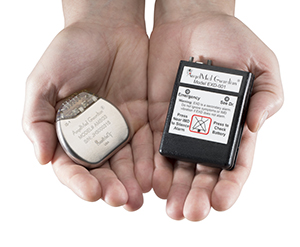
The Guardian is implanted like a single-chamber pacemaker and can be done in about 30 minutes under local anesthesia. The patient returns a week later for programming customized to their heart signal. Using AI machine-learning, the device constantly compares what is happening in the heart with a continually updating baseline, which allows it to detect changes indicative of a potential heart attack.
“It is the only device that can also 'silent' heart attacks—ones that occur when a patient has no symptoms, or atypical symptoms like heartburn,” Fischell explained. “When it detects such an event, the Guardian vibrates in the chest, and a wireless pager beeps and lights up, alerting the wearer to call 911. The next generation of this device will be connected to the internet.
“We discovered that for people who had heart attacks and who also had a Guardian installed, their time from onset of symptoms until they got to the hospital averaged an hour compared to more than eight hours in patients who had alerts turned off,” he continued. “The device saves the last twenty-four hours of data from before the alarm and up to eight hours after. That can allow doctors to see how the heart attack evolved. It's only for high-risk patients who have survived a heart attack or unstable angina event, but there are a lot of them out there.” Fischell, who was CEO of Angel Med/Avertix from 2002 through 2021, has remained active on the board of directors since 2021.
Current projects
One of the primary causes of high blood pressure relates to signals between the kidneys and brain sent over the sympathetic nerves that run along the renal artery to the kidney. In 1935, it was discovered that severing those nerves could cause a dramatic drop in blood pressure without having any other adverse effects. In 2011, Fischell and his brother Tim co-founded Ablative Solutions and developed the Peregrine® catheter that works by allowing injection of ethyl alcohol into the space outside of the renal artery to kill those nerves (Figure 3).
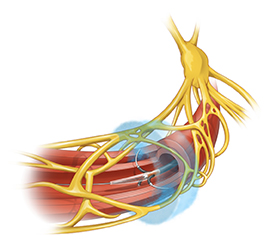
"Just 0.6 ml of alcohol, about 1/20th of a beer, will kill the nerves over about one inch—half an inch in either direction and a half an inch deep—and the patient’s blood pressure drops permanently because the nerves can't regrow,” Fischell explained. Early published data showed that use of the Peregrine could reduce blood pressure by an average of 20mm, and they are currently in the final phase of follow-ups of a large, randomized study for FDA approval with results available by early next year.
“This device could turn out to be the most successful medical device in the history of any medical device,” Fischell said.
In 2021, Fischell worked with Cornell’s Vice President for Research, Emmanuel Giannelis,on a project to identify Cornell technologies with intellectual property that could be commercialized. He found some good ones--and at least one great one. “Two professors, Alex Travis and Roy Cohen at the Baker Institute for Animal Health, had a technology so exciting that I came out of retirement to start a new company with them,” Fischell said, “The company is TETmedical, (TET stands for Tethered Enzyme Technology) and we have developed what could become the first ever blood test for stroke.”
The Cornell Years
Much of what Fischell does now is far from his original goals when he first attended Cornell.
As a boy, he loved math and science and felt that his father’s job as the chief scientist for the Space Department at the Johns Hopkins Applied Physics Laboratory was ideal. “My dad and his team of engineers would design a satellite, place it on a rocket, launch it into outer space and then play with it—and they got paid to do it!” Fischell said. “I decided that applied physics was the thing was for me. Cornell had an excellent School of Applied and Engineering Physics and a swim team that I was good enough for, so the choice was very enticing. Once I visited Cornell, I was hooked.” Although the rigorous course load for an engineering physics student prevented him from staying on the swim team (but not before he received his varsity letter in his Freshman year), he became (and remained) part of the Big Red marching and pep bands, where he wrote shows for the marching band and was elected hockey pep band conductor for three different seasons during his eight-and-a-half years at Cornell.
For his Ph.D, Fischell studied under Dr. Terrill Cool, AEP professor, working on chemical lasers. Nearly every other type of laser uses electricity as a power source, but chemical lasers use chemical reactions to fuel the material that will lase. “Literally, you build a reaction chamber, put mirrors on it, and laser light comes out without any electricity. Which is pretty cool,” Fischell said. “The work I did was based on prior work by an MIT professor and funded by the Air Force and explored what happened when the Group 3B halides*—especially scandium and yttrium—are burned with halogen gasses. We explored whether any of these might work as a chemical laser.”
“But, it turned out that the professor at MIT was wrong. The reaction did not make a good chemical laser, but the project was good enough to get my lab partner Howard Brayman and me Ph.D.s. How did we figure out he was wrong? Well, we ultimately built the most amazing looking experiment you ever would have seen—it really looked like a mad scientist laboratory. We had a 2,000°centigrade carbon furnace that had windows that you could shoot laser light through, and you could measure what came off it. But to keep it going at 2,000° centigrade, to keep things cool and collect the potentially toxic chemicals, we used liquid nitrogen to trap the gases coming out. So, there's stuff bubbling and clouds of gas flowing down. We had vacuum pumps to pump it out, and we had power supplies. My partner’s dissertation looked at the chemistry of what we had done, and mine examined the laser-induced fluorescence energy levels that we’d identified. We threw a brick—a couple of bricks—on the pyramid of knowledge, which had no real application. But it allowed two smart guys to get doctorates.”
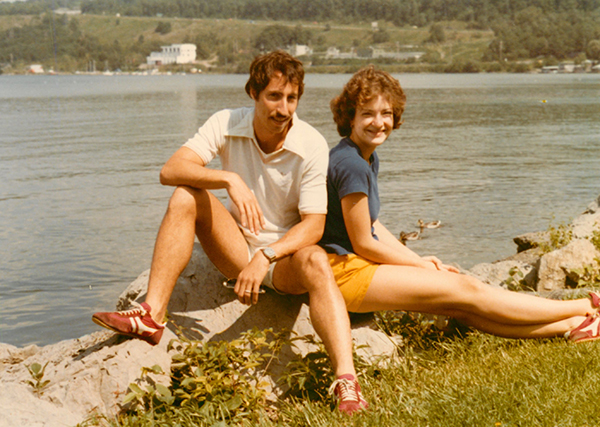
After finishing his PhD in 1980, he followed his wife, Sarah (EE ’78), a highly sought-after Cornell electrical engineer, to Bell Laboratories in Holmdel, New Jersey, as the trailing spouse.
“At Bell Labs, I began doing acoustic testing of a new microphone invented by their research division and helped get it turned into a product for teleconferencing. I also worked with the inventor of the multipoint conference call bridges for the military and learned how to make such calls clear even with a large number of connections. Two years after joining the Bell Labs, I was promoted to supervisor to evaluate and help improve the performance of the first ever digital conference bridge used in the AT&T Alliance® Teleconferencing Service. This led to further work on advance voice technologies and eventually my starting an intrapreneurship venture to bring to market a new AT&T line of products for audio and graphics teleconferencing (Go To Meeting) in 1987. Having set a record by bringing seven new products to market in fourteen months, I moved on to build the team that developed the network based technology for AT&T’s InfoWorx® service that provided information and entertainment using touch tone phones, including Amtrak’s reservation service and the Charles Schwab Telebroker® service.”
Inventor and entrepreneur
By 1990, downsizing at AT&T made career advancement difficult and it was time to move on.
“It appears that starting businesses is in the Fischell genes,” Fischell said. “My grandfather and great-grandfather were part of the Fischell start-up shoe company in Long Island City in the 1920s. In 1969, my dad, Robert, invented a rechargeable pacemaker and got a friend of his to put up the money to start what today is Abbott’s pacemaker business, now the second-largest in the world. When my brother Tim became an interventional cardiologist, the three of us started to work together. Along with my youngest brother Scott, a medical sales professional, and Dr. Adrian Upton, a renowned neurologist, we founded fourteen companies since I left the Bell Labs in 1991. Even my daughter, Erin (MAE ’10), started her first company last year.”
In 1991, Fischell left Bell Laboratories to join his father and brother doing FDA reports and inventing and writing patents for one of these startups, a company called MedInTec, Inc. In the 1990s he learned how to write patents from his father, and he has written more than 150 of his 198 issued U.S. patents.
A self-proclaimed “die-hard Cornellian,” it’s unsurprising that he would turn his interest in the medical field and development of medical devices towards Cornell, putting his energies as chair of the advisory board for the emerging program in biomedical engineering and supporting the founding of the first new department in the College of Engineering in 40 years, the department of biomedical engineering (BME). In the early 2000s, professor C. C. Chu (Human Ecology) asked Fischell to lecture on the medical technologies that he had invented.
“I learned that to make the BME program into a department, the Dean of the College of Engineering was the one to make it happen,” Fischell said. “When W. Kent Fuchs became dean in 2002, I was an early visitor into his office. I think I did help convince him of the need for a department, and later helped convince his successor, Lance Collins (2010–2020), of the need for an undergraduate BME major.” In June, 2015, BME became the Meinig School of Biomedical Engineering. In the Fall of 2023 there are 120 undergraduate students affiliated with BME—including 70 new affiliates, the largest number since the program began. Fischell currently is an adjunct professor in the Meinig School, periodically lecturing. In recent years he has also helped nominate BME faculty to the National Academy of Inventors where he is a Fellow.
Fischell has always been an ardent supporter of Cornell—starting from his days as a student and continuing to the present. While employed at Bell Laboratories, he recruited Cornell PhDs to work for that organization. He served on the Cornell Board of Trustees from 2008 until 2016, and on the Weill Cornell Board of Fellows from 2016 through 2021. He is currently a Cornell Trustee Emeritus and Presidential Counselor. One of his most rewarding connections was leading the fundraising that built the Fischell Band Center—home of the Cornell Big Red Marching and Pep Bands—and at its dedication in 2013, conducting the Alma Mater at half time with 300 current and alumni band members on the field.
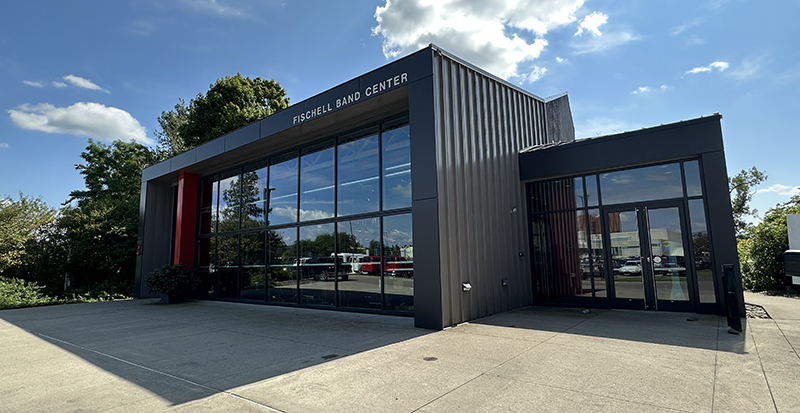
Advice for current students
Fischell believes in the potential of Cornell students. As an undergraduate student teaching assistant for Physics 1112 in 1975, he took pride in being able to explain complex topics in a way that allowed the students to connect with the ideas, and then understand the approach to reaching a solution.
“I loved teaching and was extremely proud when my section did well on the exams. When one evening I mentioned to my girlfriend Sarah—now my wife—that I really thought that this teaching thing was fun and rewarding, she said to me: ‘David, what you really like is teaching at Cornell.’ And she was right, Cornell students in 1975—and those I meet now nearly 50 years later— all have the same love of learning.”
Fischell’s advice for current students is to “pick something you like and follow it until something better comes up. Once you are at your first job, begin by knocking it out of the park to establish your reputation. As you continue, learn as much as you can about what is going on in your organization and when you find a problem that is important and interests you, ask your boss if you can take it on. Once this happens, you will rarely ever be given work, and instead, you will lead the direction of your future. Always be looking for something important where you can make a difference.”
Throughout his exceptional career, it is clear that David Fischell has followed his own advice and made a difference that benefits students, Cornell University, and millions of people worldwide.
*Group 3G halides are the first group of transition metals in the periodic table, closely related to the rare-earth elements, and contain the four elements scandium, yttrium, lutetiun, and lawrencium. All images provided by David R. Fischell, except where noted.

